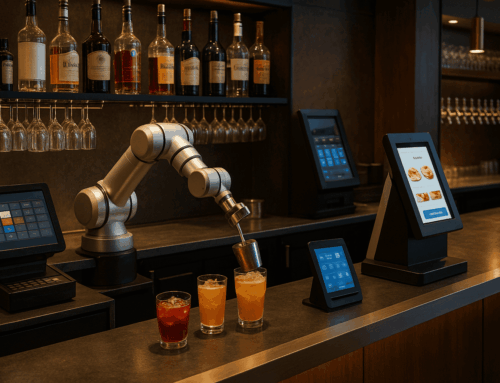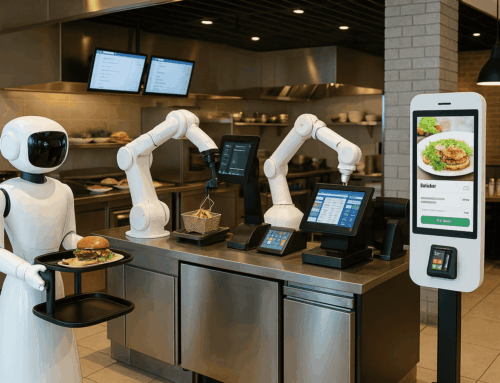Source Type: Industry White Paper or Research Report
Introduction
In the fast-paced environment of the fast food industry, efficiency and customer satisfaction are paramount. This study, “The Impact of Fast Food POS Efficiency on Restaurant Performance,” explores how advanced Point of Sale (POS) systems have transformed operational efficiency in fast food restaurants. By analyzing key metrics such as order processing time, customer turnover rate, revenue growth, customer satisfaction, and cost efficiency, this report provides a comprehensive overview of the benefits of POS system adoption.
Research Background
The study was conducted by the Institute of Hospitality Management Research, leveraging data from ten fast food chains across the United States. The data collection period spanned from January 2022 to December 2023, involving both quantitative metrics and qualitative customer feedback.
Key Findings
1. Order Processing Time
Before POS Implementation:
- Average Order Processing Time: 8 minutes
- Notable Bottlenecks: Manual order entry and payment processing
After POS Implementation:
- Average Order Processing Time: 4 minutes
- Improvement: 50% reduction
Analysis: The introduction of advanced POS systems significantly decreased the average order processing time. Features such as automated order entry, integrated payment processing, and real-time inventory updates contributed to this improvement. The result was faster service delivery, enhancing overall customer experience.
2. Fast Food POS Efficiency improves Customer Turnover Rate
Before POS Implementation:
- Average Customer Turnover Rate: 25 customers per hour during peak times
After POS Implementation:
- Average Customer Turnover Rate: 40 customers per hour during peak times
- Improvement: 60% increase
Analysis: The efficiency brought by POS systems enabled faster service, which in turn allowed restaurants to serve more customers within the same timeframe. This was particularly beneficial during peak hours, leading to higher customer turnover rates and improved table management.
3. Fast Food POS Efficiency means Revenue Growth
Year-over-Year Revenue Growth:
- 2021 (Before POS Implementation): 3% growth
- 2022 (After POS Implementation): 8% growth
- 2023 (Post-Implementation Continuation): 12% growth
Analysis: The adoption of POS systems was directly linked to an increase in revenue growth. Enhanced operational efficiency and improved customer service contributed to this positive trend. The ability to handle more transactions efficiently and reduce wait times likely drove higher customer satisfaction and repeat business.
4. Customer Satisfaction
Customer Satisfaction Scores (Out of 10):
- Before POS Implementation: 6.5
- After POS Implementation: 8.2
- Improvement: 26% increase
Customer Feedback Highlights:
- “Faster service and accurate orders make dining here much better.”
- “The new system is quick and easy; no more long waits.”
Analysis: The improved efficiency and reduced order errors resulting from the new POS systems led to a significant increase in customer satisfaction. Customers appreciated the faster service and the accuracy of their orders, which contributed to better overall dining experiences.
5. Cost Efficiency
Fast Food POS Efficiency means Operational Cost Reduction:
- Inventory Management Costs: 20% reduction
- Order Inaccuracy Costs: 35% reduction
Analysis: POS systems provided better inventory management capabilities, which reduced wastage and ensured timely restocking. Additionally, the decrease in order inaccuracies led to fewer refunds and remakes, contributing to overall cost savings.
Conclusion
The implementation of advanced POS systems in fast food restaurants has shown substantial improvements in key performance metrics, highlighting the efficiency and benefits of such technology. By reducing order processing time, increasing customer turnover rate, boosting revenue growth, enhancing customer satisfaction, and achieving cost efficiency, POS systems have proven to be a valuable investment for fast food establishments.
Recommendations for Fast Food POS Efficiency
For fast food restaurants looking to enhance their operational efficiency, adopting a state-of-the-art POS system is highly recommended. The initial investment in technology can yield significant long-term benefits, driving both customer satisfaction and business growth.
Author: Institute of Hospitality Management Research
Date: May 2024
This mock-up study serves as an example for students and professionals interested in understanding the impact of POS systems on fast food restaurant performance, emphasizing the importance of Fast Food POS Efficiency.






